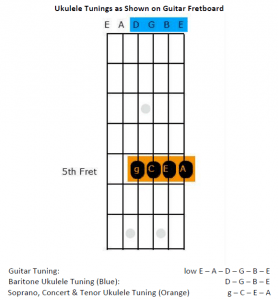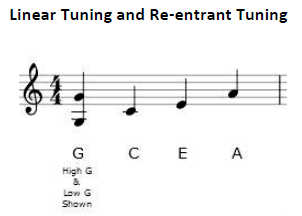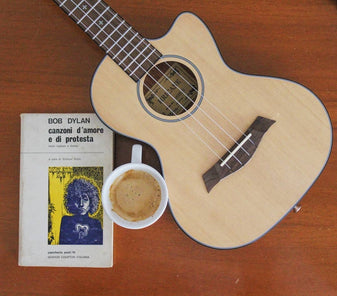How to Choose the Right Ukulele for You!
Models, Tuning, and Sizes, Oh My!
Have you noticed the variety of ukulele models and sizes available in the market today? Whether you are looking to play the ukulele for personal enjoyment or looking to pick out a set for your classroom, it can be quite overwhelming in determining what model and size you should use.
West Music is here to help make sense of features and advantages for each of the different ukulele sizes. We take the mystery out of how to choose the right ukulele for you.
Sizes of Ukuleles
There are many sizes and shapes of ukuleles available. The most common sizes are soprano, concert, tenor, and baritone. Some manufacturers make other sizes and shapes, such as the smaller piccolo or pianissimo models, bass ukuleles, banjo ukes, or the novelty pineapple shape (usually in soprano size). This article relates to the most popular, standard sizes.

The sizes are not designed to match the physical size of the player, such as in fractional sizes you would see for violin and guitars. Rather, the size is related to each size’s tone and application. Although the names of the different sizes imply different tuning, you may be surprised to learn that soprano, concert, and tenor are tuned exactly the same to each other to g’-
Ukulele for Guitar Players
The Baritone ukulele is the largest size in the ukulele family. It is the only size that uses a different tuning! Because the baritone ukulele has the same tuning as the top 4 strings of a standard 6-string guitar, it can be helpful to start with a baritone ukulele.
Guitar is tuned (from low to high) to E-A-
Soprano, Concert, and Tenor Tuning
Now that we know the relation of the Baritone ukulele tuning to guitar, we can see how the other ukuleles compare.
The smaller soprano, concert, and tenor ukuleles are tuned a 4th higher, or 5 half steps higher than the baritone ukulele. So, if we place a capo at the 5th fret of a baritone ukulele (


Re-entrant Tuning
However, the more common tuning system for the soprano is to tune the G-string up one octave, resulting in the open strings matching the melody of “My Dog Has Fleas.” The 3rd string, the C, is now the lowest open-tuned string. This is referred to as “re-entrant” tuning because the strings are not tuned linearly from low to high. It is this tuning that gives the ukulele its unique, characteristic sound!
Linear Tuning
Some ukulele methods may recommend using the “linear” tuning as it extends the lower range. Additionally, it may be easier for the player to comprehend learning to read music and playing scales. As most stock ukuleles are pre-strung with the high G “re-entrant” tuning, you may need to purchase and install the low G-strings separately if you plan on using these methods. These strings will have a different thickness, or gauge.
Note: you may also need to have a Luther reshape the groove for the nut to accommodate a thicker string to ensure it sits properly in that groove if you decide to install the low G-string.
Because of the similar tuning structure for guitar and ukulele, you can use the same fingerings to play both instruments. You will find many of the techniques carry over. If you play guitar, you can play the ukulele! Because the instruments are in a different key, you will need to transpose between guitar and ukulele. For example, a G chord on the guitar will be a C chord when played in the same fret position on the ukulele. Classroom teachers will note this is similar to the difference between soprano and alto recorders.
Soprano, Concert, and Tenor Size Comparisons
Soprano Ukulele
The soprano ukulele is also known as the “standard” size, based on the traditional ukulele sizing. The design was established from similar instruments brought to Hawaii by Portuguese immigrants in the late
Concert and Tenor Ukuleles
In the 1920s, Big Band was in full swing. To compete with the volume and sound of the Big Band instruments, the larger-bodied concert and tenor ukulele models were developed. Additionally, at this time Banjo ukuleles were introduced. These instruments are even louder than concert and tenor ukuleles. They have the same ukulele tuning, however, feature a banjo-style body with the bridge resonating on a taut head to produce a banjo-type tone.
The larger bodies of the concert and tenor size ukuleles produce more volume and a fuller sound in the middle and lower tonal ranges. The larger sizes usually have more frets, averaging 15-20, and more space on the fret board. This allows more room for fingers when making advanced chords. As a result, the more common soprano may appear to sound higher pitched or “plinky” than the larger sizes. You may find the tenor sounds more like a guitar, even with the same tuning. The concert size produces a tone somewhere in-between!
The tenor size is preferred among many stage performers and instrumentalists as it typically has the most space between frets, the highest number of playable notes, and the fullest dynamic range.
The concert size is a good compromise between the two. It blends the physical and tonal characteristics of the soprano and tenor models together. It has more frets, like the tenor, but still retains the signature sound of the soprano – albeit with a touch more volume and tone. Some players will like this size for its good mix of the other two sizes’ traits and if their fingers may feel most comfortable on this in-between sized fret board.
Choosing the Right Size Ukulele
Realistically, you could begin playing on any size ukulele, but soprano is by far the most popular choice. It has a lower cost and smaller size which makes it easier to store. It is ideal for many beginners to learn the basics of chord positions and for those who will not play beyond the soprano’s limited range of 12 frets.
Selecting the right size ukulele for yourself is mostly personal preference. There is not a “wrong” choice! Rather than selection based on size, try choosing the right ukulele for you based on the following criteria.
Look
You will want to pick one that appeals to your senses. Most players go for a model that reflects their personality. You are going to be the one seeing this ukulele; will it inspire you to play? Will you be dabbling in ukulele as a novelty or as a serious instrument? Are you looking for a ukulele that will be on display? Ukuleles make great conversation pieces so make it fun!
Tone
Instruments can vary quite a bit in sound and volume. You may want to play, listen to sound samples, and read reviews on models. Aquila Nylon strings are the standard in the industry for most entry-level and intermediate ukulele models. These strings produce a full, voluminous tone.
Budget
Larger sized concert and tenor ukuleles will cost incrementally more than sopranos. Simply put, they require more raw materials to construct.
Some ukuleles can be considerably more expensive if crafted of solid woods versus laminate woods. However, each model may sound different and not necessarily better with solid wood. You can have a great tone with a laminate body that will feature the aesthetics of a solid body without the price. With a laminate body, manufacturers can get a thinner top than solid wood. Resulting in more vibration and increased sound. The veneer finish still features the beauty of wood grain and may have better durability as they are less sensitive to humidity and temperature.
Solid wood model ukuleles are often more expensive than laminate. That is to say because of the raw materials including exotic woods, the craftsmanship involved, and attention to detail. The sound quality of solid wood instruments improves as the wood ages. They also require more care and humidification in drier climates and seasons to avoid cracking or warping.
Summary
For beginners, the most common choice will be the soprano size because of its price. You may consider a larger or more expensive model for a fuller tone, larger fret board, more versatility, and the ability to “grow into it.” Realistically there is no right or wrong ukulele to start on but consider these factors just like Goldilocks did in the classic fairy tale “Goldilocks & the Three Bears” to find the one that is just right for you and your budget!






